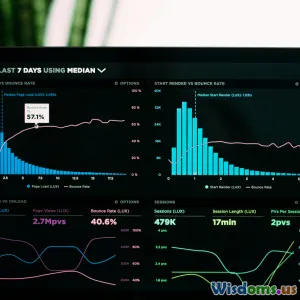
Why Data Visualization Can Mislead and How to Avoid It
9 min read Explore how data visualization can mislead and practical strategies to create accurate, trustworthy charts and graphs. (0 Reviews)
Why Data Visualization Can Mislead and How to Avoid It
Data visualization is often hailed as the best way to communicate complex information quickly and effectively. A compelling chart or graph can distill mountains of data into a visual story that sparks insight and prompts decisions. However, just as strongly as visuals can clarify, they can also confuse or mislead. The very tools designed to bring transparency to data can, if improperly constructed or interpreted, become conduits of misunderstanding.
In this article, we’ll explore why data visualization can be misleading, dissect real-world examples where it has led people astray, and provide expert advice on how to design visualizations that truly illuminate rather than obscure the data’s message.
Understanding the Power and Pitfalls of Data Visualization
Historically, data visualization has driven enlightenment—from Florence Nightingale’s rose diagrams exposing sanitation issues in military hospitals to John Snow’s cholera outbreak maps in London. Their visuals did not just inform; they inspired change.
Yet, when data visuals misrepresent facts, they risk eroding trust and impairing decision-making. Misleading visualizations are not always due to malicious intent; often, they arise from poor choices, misinterpretations, or an unawareness of best practices.
This section highlights the primary reasons why visualizations lead to misunderstanding.
1. Manipulating Axes and Scales
A classic way visualizations mislead is through axis manipulation. Consider a bar chart tracking a company’s revenue growth. If the Y-axis is truncated—say starting at $900 million instead of zero—the bars may exaggerate perceived growth. Conversely, using inconsistent scales within the same dashboard causes comparisons that aren’t on equal footing.
Example: In 2017, a political chart circulated widely, showing salary growth where the Y-axis started at $50,000 instead of zero, making modest gains look dramatic. This fueled misinterpretation and debate.
How to Avoid:
- Always start quantitative axes at zero unless a deep rationale exists.
- Label axes clearly with consistent intervals.
- Use breaks cautiously and signify them visibly.
2. Cherry-Picking Data Points
Showing only selected data frames or summary statistics can distort context. For instance, displaying only the peak point in a dataset, ignoring dips or periods of stagnation, can create a misleading impression.
Example: A fitness tracker app that highlights a user’s highest daily step count without showing days with low activity gives a skewed sense of regular success.
How to Avoid:
- Include full datasets or representative sampling.
- Use trend lines or aggregates that account for variability.
3. Using Improper Chart Types
Choosing the wrong chart type can confuse or exaggerate certain aspects. Pie charts with too many slices are hard to interpret; 3D charts often distort proportionality.
Example: A 3D pie chart may make some segments look larger than reality because of perspective illusion, skewing visual comparison.
How to Avoid:
- Opt for simple, clean chart types (e.g., bar charts for comparisons, line charts for trends).
- Avoid 3D graphics unless spatial data justify it.
4. Neglecting Context and Annotations
Data points without necessary context can mislead. For example, a sharp spike in unemployment rates needs contextual notes about economic disruptions.
A chart that merely says "Unemployment Spiked" without clarifying it's due to an exogenous event can fuel misinterpretation.
How to Avoid:
- Add annotations, titles, and source citations.
- Provide contextual explanations alongside visuals.
Real-World Cases of Misleading Visualizations
Case Study 1: The Misleading COVID-19 Graphs
During the early months of the pandemic, many dashboards and news outlets rushed to present case growth data. Some visualizations used logarithmic scales without explaining them, making it hard for the public to grasp the severity.
Moreover, changing reporting standards caused spiky graphs that appeared as misleading sudden surges.
The takeaway here is that complexity in data often requires clear communication of methods to prevent confusion.
Case Study 2: Financial Reports and Exaggerated Growth
In 2015, a startup’s investor pitch prominently displayed exponential growth charts. Closer inspection revealed that the Y-axis began far above zero, inflating perceived values.
Investors later cited this as a warning lesson on scrutinizing axes and data sources rather than taking visuals at face value.
How to Build Honest, Effective Data Visualizations
Science and art blend in data visualization—balancing clarity with integrity while making information engaging. Below are essential strategies for creating trustworthy visuals.
1. Prioritize Data Integrity
Never modify data to fit a narrative. If corrections are necessary, document them transparently.
Quote: Edward Tufte, pioneer of visualization, stated: "Above all else show the data."
2. Choose Appropriate Visualization Types
Match your message with the chart type:
- Use line charts to depict trends over time.
- Bar charts serve categorical comparisons.
- Scatter plots reveal correlations.
Stick to conventional types until the audience masters reading them.
3. Use Clear, Consistent Scales
Avoid truncating axes unless it is vital, and notify viewers if you do. Axis labels should be readable and precise.
4. Apply Color Thoughtfully
Colors evoke emotions and aid comprehension. Be consistent (e.g., red for decreases or danger), avoid overly bright or clashing palettes, and consider color-blind friendly schemes.
5. Provide Context and Explanations
Include relevant annotations, point out important observations, and cite data sources. Context turns raw data into actionable knowledge.
6. Test Your Visuals with Others
An external review helps detect misinterpretations or confusing elements you may overlook.
Tools and Resources to Improve Your Visualizations
- Data Visualization Books: The Visual Display of Quantitative Information by Edward Tufte; Storytelling with Data by Cole Nussbaumer Knaflic.
- Software: Tableau, Power BI, Python’s matplotlib and seaborn.
- Online Courses: DataCamp’s visualization courses, Coursera’s data visualization specialization.
Conclusion
Data visualization holds transformative power, but with this power comes a responsibility to communicate facts accurately. Misleading data visuals can damage credibility and lead to poor decisions. By understanding common pitfalls—such as axis manipulation, cherry-picking, inappropriate chart types, and omission of context—and adopting best practices focusing on clarity and integrity, you can create visuals that both captivate and inform.
Let every chart you create honor the data’s truth and empower your audience to better understand the story behind the numbers.
Your viewers deserve nothing less.
If you want to master data visualization, commit to continuous learning and refining your craft—your integrity as a data storyteller depends on it.
Rate the Post
User Reviews
Popular Posts


















